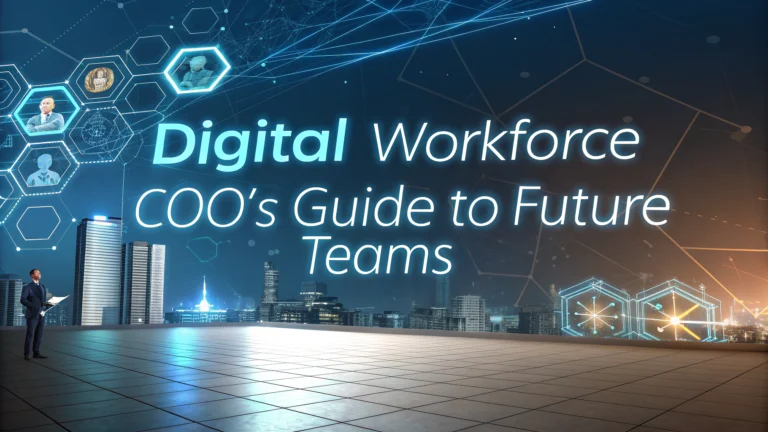A successful Chief Operating Officer must understand how to build, manage, and optimize the digital workforce to stay competitive and drive business growth.
Digital transformation has reshaped traditional team structures, introducing new roles, technologies, and ways of working that require strategic adaptation.
This quick guide explores practical strategies for COOs to create high-performing digital teams while addressing common challenges in the modern workplace.
Building Your Digital Dream Team
The ideal digital workforce combines technical expertise with soft skills that enable effective collaboration across virtual environments.
- Data Scientists and Analysts
- Digital Project Managers
- Cloud Architecture Specialists
- AI/ML Engineers
- Digital Product Managers
- UX/UI Designers
- DevOps Engineers
Essential Technologies for Digital Teams
- Project Management: Asana, Jira, or Monday.com
- Communication: Slack, Microsoft Teams
- Collaboration: Google Workspace, Microsoft 365
- Cloud Infrastructure: AWS, Azure, or Google Cloud
- Development Tools: GitHub, GitLab
Remote Work Best Practices
Set clear expectations for work hours, availability, and response times across different time zones.
Implement regular virtual check-ins and team-building activities to maintain connection and engagement.
Use asynchronous communication methods to accommodate flexible schedules while maintaining productivity.
Performance Metrics for Digital Teams
| Metric | Description |
|---|---|
| Sprint Velocity | Work completed per sprint cycle |
| Time to Market | Speed of product/feature delivery |
| Customer Satisfaction | User feedback and ratings |
| Employee Engagement | Team satisfaction and retention |
Security and Compliance
Implement robust cybersecurity measures for remote work environments.
- Regular security training for all team members
- Multi-factor authentication
- VPN access for sensitive data
- Regular security audits
Budget Optimization
Balance investment in technology with team development needs.
- Software licenses and subscriptions
- Training and certification programs
- Hardware and equipment allowances
- Cloud resource management
Moving Forward with Digital Teams
Create a culture of continuous learning and adaptation to keep pace with technological changes.
Focus on outcomes rather than processes to drive innovation and efficiency.
For additional resources and consultation on building digital teams, contact the Digital Transformation Institute at [email protected] or visit their website at www.digitaltransformation.org.
Change Management Strategies
Implement a structured approach to help teams adapt to digital transformation.
- Clear communication of changes and expectations
- Phased implementation of new technologies
- Regular feedback loops and adjustment periods
- Support systems for technology adoption
Cross-functional Collaboration
Enable seamless interaction between different digital teams and departments.
Integration Points
- Shared documentation repositories
- Cross-team sprint planning
- Joint retrospectives
- Collaborative innovation sessions
Talent Development and Retention
Create growth opportunities to maintain a competitive digital workforce.
- Personalized learning paths
- Mentorship programs
- Technical certification support
- Career progression frameworks
Digital Innovation Pipeline
Establish processes for continuous improvement and innovation.
- Innovation labs and hackathons
- Proof of concept frameworks
- Rapid prototyping cycles
- Customer feedback integration
Powering Tomorrow’s Digital Success
Building and managing digital teams requires a balanced approach to technology, talent, and organizational culture. Success depends on creating an environment that promotes innovation while maintaining security and efficiency.
Focus on developing adaptable frameworks that can evolve with technological advances and changing business needs. Invest in both tools and people to create sustainable digital capabilities that drive long-term business value.
Remember that digital transformation is an ongoing journey rather than a destination. Stay committed to continuous improvement and remain open to new ways of working as technology and market demands evolve.
FAQs
- What is a digital workforce and how does it impact the COO’s role?
A digital workforce combines human employees, AI, automation, and digital tools working together to achieve business objectives. COOs must oversee this integration and ensure optimal collaboration between human and digital workers. - How can COOs effectively manage the transition to a hybrid human-digital workforce?
COOs should implement change management strategies, provide comprehensive training programs, establish clear governance frameworks, and develop new KPIs that account for both human and digital performance metrics. - What are the key technologies driving digital workforce transformation?
Robotic Process Automation (RPA), Artificial Intelligence (AI), Machine Learning (ML), Natural Language Processing (NLP), cloud computing, and collaborative platforms are the primary technologies enabling digital workforce transformation. - How do you measure the ROI of digital workforce investments?
ROI can be measured through productivity gains, cost savings, error reduction rates, processing time improvements, employee satisfaction scores, and customer experience metrics. - What skills should COOs prioritize when building future teams?
Digital literacy, data analytics, artificial intelligence expertise, change management capabilities, agile methodologies, and strong collaboration skills are essential for future teams. - How can COOs ensure cybersecurity in a digital workforce environment?
Implement robust security protocols, regular training programs, access management systems, data encryption, and compliance monitoring while maintaining collaboration between IT security and operations teams. - What are the main challenges in managing a digital workforce?
Key challenges include resistance to change, technology integration issues, skills gaps, data security concerns, maintaining human engagement, and ensuring seamless human-digital collaboration. - How should COOs approach upskilling and reskilling in the digital age?
Develop comprehensive learning and development programs, implement mentoring systems, partner with educational institutions, and create personalized learning paths aligned with technological advancement. - What governance structures are needed for digital workforce management?
Establish clear policies for digital tool usage, automated decision-making frameworks, performance monitoring systems, and ethical guidelines for AI and automation implementation. - How can COOs maintain team cohesion in a digital-first environment?
Focus on creating inclusive digital cultures, implementing effective communication tools, establishing virtual team-building activities, and maintaining regular feedback mechanisms.
